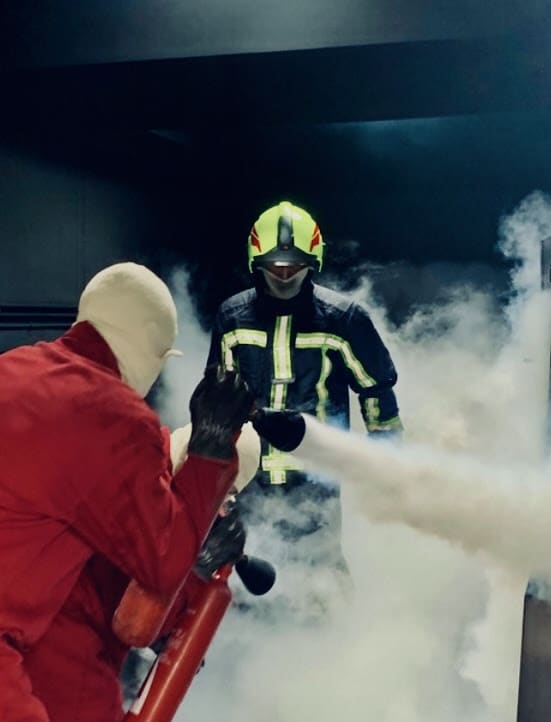How do you organize a fire training course?

Organizing fire training is a crucial step in ensuring safety within the company. This training, which is compulsory by law, provides in-depth knowledge of fire-related risks and the measures to be taken to deal with them. It includes the use of a fire extinguisher, evacuation procedures and fire prevention. A methodical approach will enable you to define clear objectives and choose the right training program.
The importance of corporate fire training
Corporate fire training is essential to ensure the safety of employees and property. In the event of a fire, well-trained employees can react quickly, reducing the risk of serious injury and property damage.
Skills acquired include fire extinguisher handling and rapid evacuation of premises. Regular practical exercises help reinforce these skills and ensure a coordinated response in the event of an incident.
Here are the benefits of effective fire training:
- Preparing employees for emergencies
- Reducing human and material losses
- Improving well-being in the workplace
A concrete example is the use of virtual reality to simulate fire scenarios, offering participants an immersive and formative experience. This innovative approach increases employee commitment and improves their reflexes in real-life situations.
Legal obligations and labor code regulations
The French Labor Code, through articles such as R4227-28 and R4227-39, requires employers to guarantee fire safety for their employees. This includes regular training for all employees, whatever the size of the company. This training must include practical exercises, such as fire extinguisher use and evacuation organization, to ensure that every employee knows how to react in the event of a fire.
Compliance with these obligations is essential to avoid legal penalties. Employers must also ensure that adequate extinguishing equipment is available and in good condition. In the event of a fire, well-trained fire wardens and fire wardens can facilitate a rapid and orderly evacuation, minimizing risks to personnel. Effective training can save lives and preserve the company's integrity.
Key elements for preparing a fire training course
For optimum preparation of a fire training course, several key elements need to be taken into account. Identifying the specific needs of the company and its employees is essential. This enables the training content to be adapted to the risks specific to the establishment.
It is advisable to define precise objectives for each training session. These may include learning the principles of combustion, recognizing the ways in which fires spread, or mastering the right reflexes in the event of a fire breaking out.
Composing a program balanced between theory and practice ensures complete understanding. Here are some points to include:
- Use of extinguishers adapted to different types of fire
- Efficient evacuation organization with defined roles for guides and support staff
- Fire alarm simulation to familiarize employees with emergency procedures
These elements ensure that training is both appropriate and effective, reinforcing overall safety.
Evacuation drills and simulations: mandatory steps
Evacuation drills and simulations are essential to effectively prepare employees to react in the event of a disaster. They test participants' knowledge and improve their responsiveness in the event of an emergency.
To optimize these exercises, it is essential to follow certain steps:
- Define a realistic scenario: simulate a fire with obstacles such as smoke.
- Training guides and handrails: their role is crucial in directing occupants to emergency exits in complete safety.
- Evaluate performance: after each exercise, a debriefing helps identify areas for improvement.
A concrete example would be the use of non-toxic smoke to simulate emergency situations. These tools make the experience more immersive and prepare participants for real-life conditions.
Prevention, an essential aspect of fire training
To integrate prevention effectively into fire training, several elements need to be taken into account. Employee awareness of fire risks is fundamental. This includes recognizing dangerous situations and adopting preventive behaviors.
Organizational and technical measures are essential:
- Regularly assess the risks present in the company
- Carry out periodic inspections of equipment to ensure proper operation
- Ensure fire alarms are operational
Regular training courses familiarize staff with evacuation procedures and fire-fighting equipment. For example, simulating the onset of a fire with a practical exercise can improve employee responsiveness. These actions reinforce overall safety and minimize the risk of a major disaster.
Who can provide fire training?
Fire training can be provided by a number of different providers. You can train your employees in-house, provided you have a qualified trainer on staff. This trainer must be competent to teach evacuation techniques and the use of fire extinguishers.
If this is not an option, you can turn to an organization specialized in fire safety. These training centers are staffed by certified instructors who offer a program tailored to your company's needs.
It is also possible to work with fire safety officers holding the SSIAP diploma. They are authorized to run training sessions and organize evacuation drills. To guarantee effective training, make sure that the program complies with current standards and meets the specific requirements of your establishment.
Frequency and renewal of fire training
Fire training must be renewed regularly to maintain employee vigilance and efficiency. According to recommendations, a refresher course is often required every two to three years. This ensures that acquired skills remain up to date, and that employees are ready to react quickly in the event of a fire.
A higher frequency, every six months, is recommended for evacuation drills. These sessions test not only staff responsiveness, but also the effectiveness of the evacuation procedures in place.
By incorporating realistic scenarios, such as the use of smoke grenades, you can reinforce trainees' experience. It's also crucial to adapt training content to the specific risks associated with the company's activity, for optimum prevention.
Setting up a fire response plan
There are a number of key steps involved in drawing up a fire response plan. Firstly, appoint first-response team members who can act quickly in the event of an outbreak of fire. These team members must be trained to use fire extinguishers and secure the area.
Next, define assembly points to ensure the safe evacuation of all occupants. It is essential to coordinate this stage with regular drills to ensure the plan's effectiveness.
It is also crucial to clearly identify and mark evacuation routes. These paths must be kept clear to enable rapid evacuation in the event of an emergency. Finally, establish clear communication with the fire department to facilitate their intervention. Integrating these elements will ensure a safe and effective response in the event of fire.
Assessing what you've learned after fire training
A variety of tools can be used to assess what has been learned after a fire training course. Practical tests and fire simulations are crucial for measuring training effectiveness. These exercises help identify whether theoretical skills have been correctly assimilated.
Another aspect to consider is the use of evaluation questionnaires. These questionnaires enable participants to give their opinion on the quality of the training and express their level of satisfaction.
Cold assessment, carried out a few months after training, is also essential. It enables us to check whether the skills acquired are being applied in the workplace.
In conclusion, a well-structured evaluation ensures that the training program meets its objectives and enables content to be adjusted for future sessions, thus ensuring continuous improvement.


